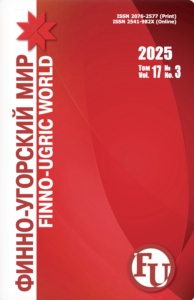DOI: 10.15507/2076-2577.010.2018.02.109-120
On theoretical approaches to the study of areal features of the traditional Mordvian polyphony
Liudmila B. Boiarkina,
Candidate Sc. {Art History}, Senior Research Fellow,
Interregional Research Center of Finno-Ugric Studies,
Ogarev Mordovia State University
(Saransk, Russia), bojarkin_ni@mail.ru
Among the current challenges in modern ethnomusicology, the studies of folklore have pioneered polyphony, a characteristic phenomenon of traditional Finno-Ugric music. The polyphony of Finno-Ugrians reveals noticeable ethnic (subethnic and local) differences that were defined during a long historical development (contacts with neighboring peoples and mutual influence of areal musical traditions). The solution of conceptual analytical problems, the development of modern theoretical approaches and techniques are put forward as important ethnomusicological problems. The subject of the article is Mordovian folk polyphony; its goal is to identify relevant characteristics in order to establish system-forming constants of areal traditions. The works of national and foreign scholars on the issues of areal studies, mapping and classification made up the general theoretical and methodological base.
The materials were authored field (including multi-channel) sound recordings of folk music and their analytical score transcriptions; published notations of other ethnomusicologists are also taken into consideration. Reliability and validity of the research are provided by methods of system-typological analysis of an extensive research base and its analysis.
At areal investigations of Mordovian polyphonic traditions, characterized by the presence in them of complex interactions of stadially different forms of melody and texture, it is necessary to systematize the constant correlations between the melodic (horizontal) and the harmonic (vertical) components at the level of both the integral structure of polyphonic melody or gigantic, and individual vocal parts. There are the following attributes applicable to all known types of polyphonic texture: relation of melody to harmony (according to the principle of opposition by E. V. Gippius), realization of a melodic type in a polyphonic texture, and heterophonic “density” of functionally allocated voice parts.
On the basis of these characteristics, it is possible to reveal quite clearly the system-forming properties of the polyphony of different regions. The areas can be allocated in the presence of either a stable style component that does not occur in other areas, or a stable system group of properties characteristic of a certain group of genres.
Key words: musical tradition; style area; genre group; structural type; melodic; polyphonic texture; signs; monody; heterophony; burdon polyphony.
For citation: Boiarkina LB. On theoretical approaches to the study of areal features of the traditional Mordvian polyphony. Finno-ugorskii mir = Finno-Ugric World. 2018; 2: 109–120. (In Russian)






















